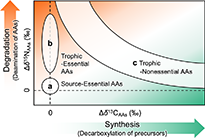** Progress in Earth and Planetary Science is the official journal of the Japan Geoscience Union, published in collaboration with its society members.
Gallery View of PEPS Articles
Research
Biogeosciences
202009202009
A new insight into isotopic fractionation associated with decarboxylation in organisms: implications for amino acid isotope approaches in biogeoscience
Yuko Takizawa, Yoshinori Takano, Bohyung Choi, Prarthana S. Dharampal, Shawn A. Steffan, Nanako O. Ogawa, Naohiko Ohkouchi, Yoshito Chikaraishi
compound-specific isotope analysis, amino acids, nitrogen, carbon, trophic discrimination, deamination, decarboxylation, degradation, synthesis, isotope physiology
Fig. 1. Simplified metabolic map of degradation and synthetic networks of the amino acids (i.e., glycine, alanine, valine, leucine, isoleucine, glutamic acid, and phenylalanine) with respect to isotopic fractionation.
Fig. 2. Possible classification of amino acids: (a) Source-Essential, (b) Trophic-Essential, and (c) Trophic-Nonessential on the cross-plot of the Δδ15N and Δδ13C values.
Stable nitrogen (15N/14N) and carbon (13C/12C) isotopic compositions of amino acids in organisms have widely been employed as a powerful tool to evaluate resource utilization and trophic connection among organisms in diverse ecosystems. However, little is known about the physiological factors or mechanisms responsible for determining the isotopic discrimination (particularly for carbon) within amino acids of organisms. In the present study, we investigated the inter-trophic discrimination of nitrogen and carbon isotopes within amino acids (Δδ15NAA and Δδ13CAA, respectively) using four consumer–diet pairs. Each pairing illustrates a metabolic perspective of isotopic fractionation of amino acids. The Δδ15NAA values in these combinations reveal a trend consistent with those observed in many other combinations in previous studies. This further validates a standard scenario: the deamination preferentially removes 14N amino group from diet-derived amino acids, leaving behind the 15N-enriched amino acids in consumer biomass. The Δδ15NAA values thus mirror the activity of amino acid deamination in consumers. In contrast, the trends in the Δδ13CAA value suggest a different metabolic fate for the amino acid carbon isotope. Based on our results, we predict the following scenario: decarboxylation preferentially removes 12C α-carbon (i.e., carbonyl-carbon) from pyruvic acid in glycolysis, and from α-ketoglutaric acid in the tricarboxylic acid cycle, leaving behind the 13C-enriched both pyruvic and α-ketoglutaric acids. The 13C is then transferred to amino acids that are synthesized from the 13C-enriched precursor molecules within consumers. The Δδ13CAA values therefore mirror the pathways of de novo amino acid synthesis in consumers. The proposed link between nitrogen and carbon isotopes can refine our knowledge of the potential processes affecting the isotopic fractionation within diet and consumer compartments, as well as environmental samples.







